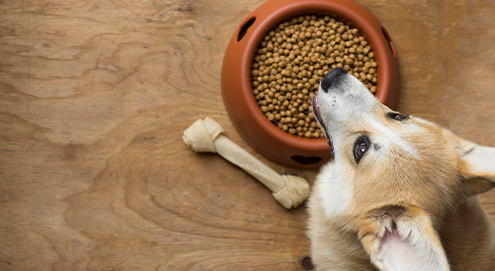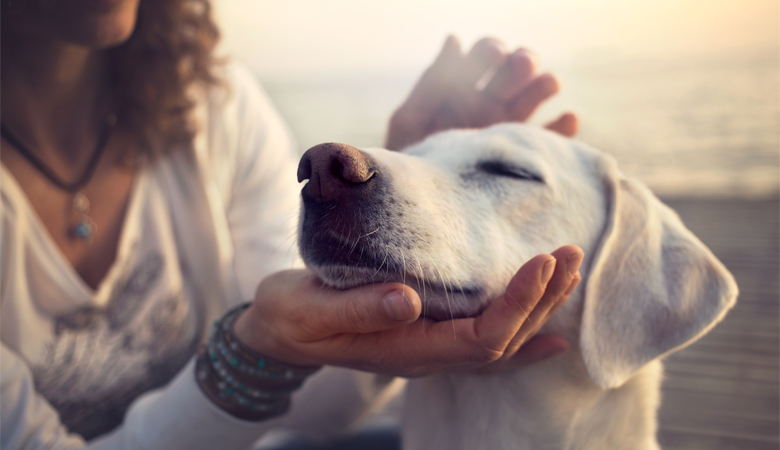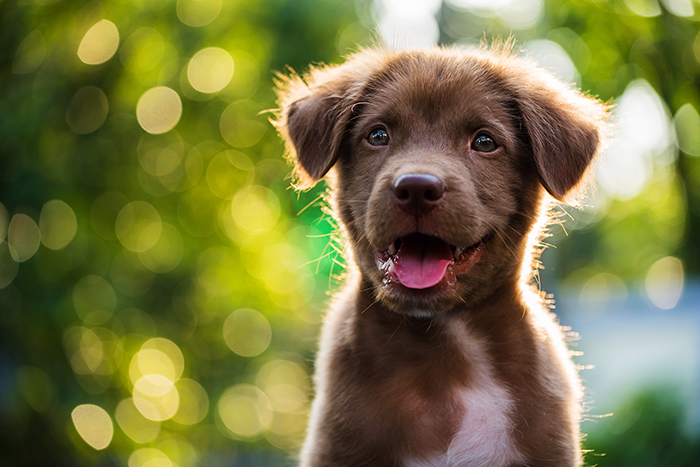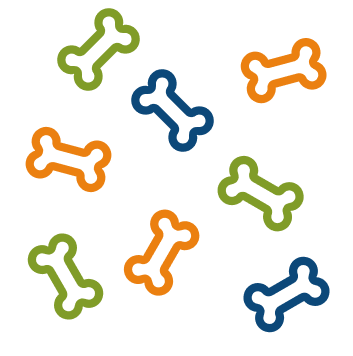What causes food guarding in dogs?
Food guarding often develops due to a combination of past experiences, character and circumstances. The behaviour itself is natural. In the wild, dogs and their ancestors, wolves, have to defend their food in order to survive. In pet dogs however it is usually seen as problem behaviour, especially when there is growling or even biting involved. Below are the most common causes:
Past experiences with food shortage or competition
Dogs that as puppies had to “fight” for food with several littermates, or that come from a shelter or poor breeding conditions where food was scarce, can develop persistent guarding behaviour. They have learned: “If I do not protect it, I will lose it.”
Food that is taken away regularly
Well meant actions by owners, such as testing whether a dog will surrender their bone, can actually trigger food guarding. By repeatedly taking away food or a toy without giving anything in return, your dog learns that they can lose something important whenever someone comes near.
A feeling of insecurity or lack of trust
Dogs that do not feel safe while eating, for example because there is a lot of hustle and tension in the house, may start to guard their food. They build up stress around mealtimes, which can show as food bowl aggression.
Character traits or breed sensitivity
Some breeds or individual dogs have a naturally stronger tendency to guard possessions. This may be seen in dogs with a more independent or watchful nature. Sensitive or insecure dogs can also be quicker to react around food.
Physical discomfort or stress
Pain, illness or general stress can intensify food guarding. Think of a dog with joint pain who finds it unpleasant when someone comes close while they are eating, or a dog with an overactive nervous system that reacts more quickly to perceived threats.
Sometimes food guarding appears suddenly, for example after a negative experience. In other cases the behaviour creeps in gradually, especially in young dogs during adolescence when they are more sensitive to stimuli and are testing boundaries. Pay attention to when and how the behaviour started. The earlier you recognise and address food guarding, the easier it is to change.
What can you do about food guarding in dogs?
Food guarding needs a calm and consistent approach. It is important to understand that this behaviour comes from a feeling of insecurity or not feeling safe. Punishing, scaring or shouting usually makes things worse. It increases stress and makes your dog even more afraid of losing their food.
The key is to build trust, prevent conflicts and offer structure and predictability. Below are the most important steps:
1. Create a safe feeding environment
Give your dog a quiet place where they can eat undisturbed, without hustle or competition. This will help them feel safer and reduces the chance that they feel the need to guard their food.
- Let your dog eat without distractions. No children, other pets or people leaning over them.
- In multi dog households, always feed dogs separately, preferably in different rooms.
- Prevent dogs from eating out of each other’s bowls. This is a very common cause of food bowl disputes.
- Provide a fixed feeding spot and regular feeding times. This gives calm and predictability.
2. Build trust around the food bowl
Many dogs with food guarding have learned that people take things away from them. You want to show the opposite: that your presence does not take anything away, but actually adds something positive.
- Do not approach your dog suddenly from the side or from above while they are eating.
- Now and then toss a very tasty treat into the bowl while your dog is eating, without disturbing them.
- Practise at a distance first. Walk past calmly while you add something, and only come closer if your dog remains relaxed.
- Make your actions predictable. Telling your dog what you are about to do can be reassuring for many dogs.
3. Train swapping
A dog that learns that giving something up brings them something better, is less inclined to guard. This is often called the swap or trade technique.
- Start with objects your dog cares little about, such as a toy or an older chew that is less interesting.
- Use a clear cue, for example “swap” or “leave”, and immediately offer something better.
- Build this up gradually. Only when your dog swaps calmly should you move on to more valuable food or snacks.
- Never force it. Pressure usually increases guarding behaviour.
Tip: swapping is not only useful for food guarding, but also for toys, socks or other items your dog should not have.
4. Use helpful tools
Food puzzles and licking mats are ideal to make mealtimes less tense and to give your dog mental stimulation. They slow down eating and help to shift the focus away from simply “owning” the food.
- Choose a puzzle or licking mat that suits the type of food (wet food, kibble, etc.).
- Divide the food over several spots so your dog has to search for it.
- This turns eating into an activity instead of a stressful moment.
- Also very useful in multi dog households: each dog gets their own puzzle in their own place.
Does your dog bite or is the behaviour very intense?
If your dog growls fiercely, lunges or bites in situations related to food, or if there is resource guarding towards other dogs or people, it is wise to seek help from a qualified behaviourist and/or your vet. There may be underlying stress, pain or fear that also needs to be addressed.
With patience, consistency and respect for your dog’s boundaries, food guarding can be guided well. Every small step towards relaxation is a win, for both you and your dog.
Do you have questions about food guarding in dogs? Please contact us at veterinarian@vetsend.co.uk.








